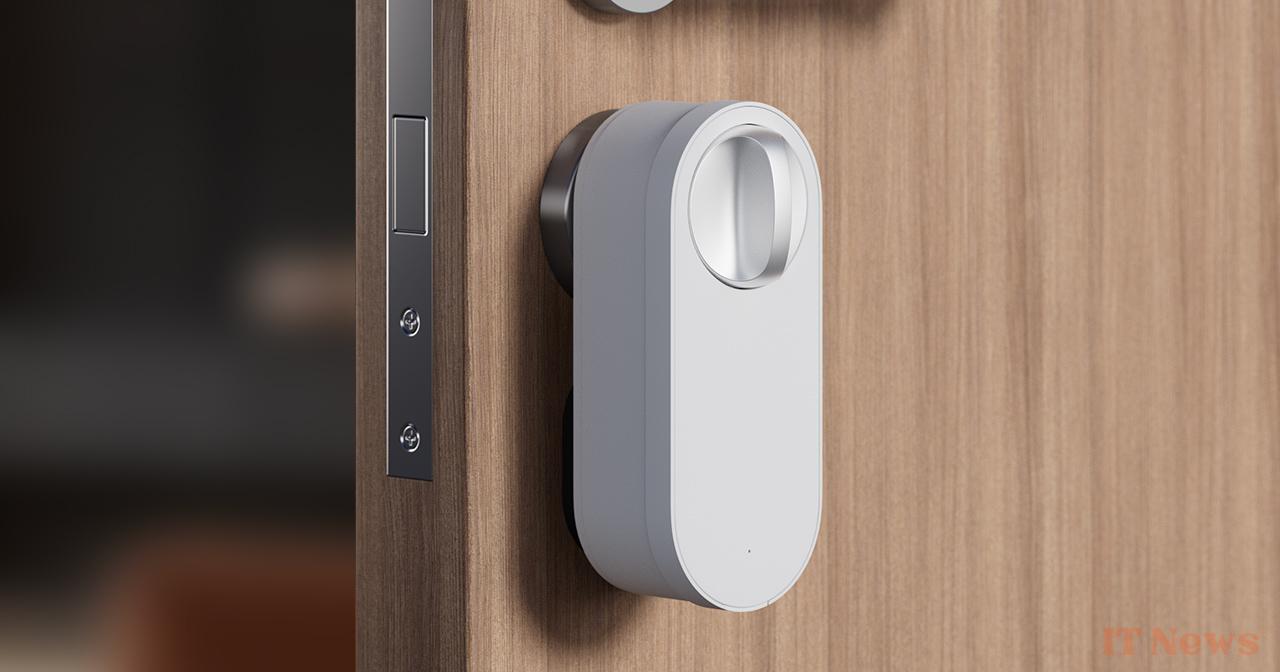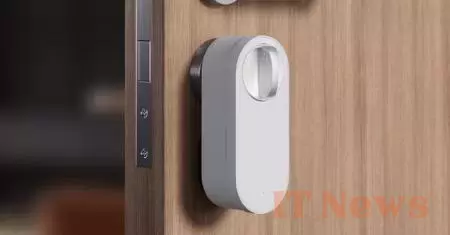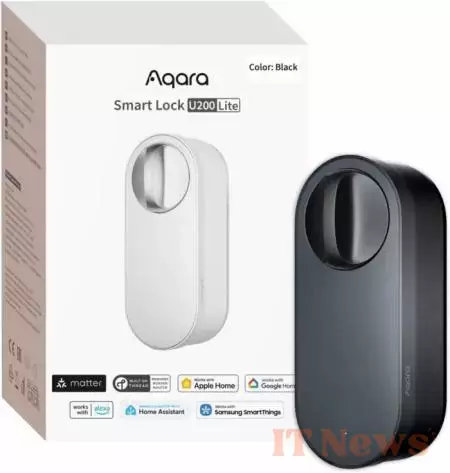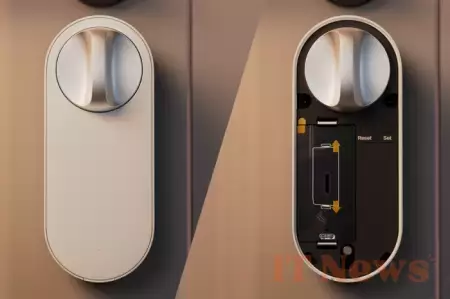After thoroughly testing the Aqara Smart Lock U200 connected lock a few months ago, we're now looking at the new Lite version, freshly announced today by the Asian brand. The manufacturer is announcing a more accessible, more compact model without losing any features while retaining the essential Matter compatibility. It's been installed in my home for several weeks now, connected to an Apple HomeKit system and quite a few other Aqara products. How does it perform in use? We'll try to find out if this version is truly lightweight or not!
Aqara Smart Lock U200 vs. Aqara Smart Lock U200 Lite Comparison
After testing the full U200 version, switching to the U200 Lite quickly reveals a different approach: lighter in features, but also in price and size.
The main difference lies in the opening methods. The classic U200 offers a fingerprint reader, Apple HomeKey support (unlock with iPhone or Apple Watch), and an included keypad allowing code entry. The U200 Lite, on the other hand, does without these three elements. It only offers opening via Bluetooth/Matter with a smartphone or via an NFC card or tag (MIFARE type, 2 stickers provided).
In terms of design, the Lite is more compact and lighter, which makes it easier to integrate into thinner doors or in homes where discretion is a priority. It retains a USB-C rechargeable battery with a battery life equivalent to the classic version (around 6 months), but without a battery backup system.
Obviously, there is also a price difference of around €140.
| Features | Aqara U200 Classic | Aqara U200 Lite |
|---|---|---|
| Opening methods | Smartphone, fingerprint, keypad, NFC, Apple HomeKey | Smartphone, NFC only |
| Fingerprint | Yes | No |
| Keypad (included or possible) | Yes (included) | Not compatible |
| Apple HomeKey | Yes | No |
| NFC compatibility | MIFARE | MIFARE (stickers provided) |
| Connection | Bluetooth, Thread (Matter) | Bluetooth, Thread (Matter) |
| Main battery | USB-C rechargeable (approximately 6 months) | USB-C rechargeable (approximately 6 months) |
| Price | €269.99 | €127.99 |
Installation and configuration of the Aqara Smart Lock U200 Lite
Installation and calibration
Installation is a bit tedious on the Aqara Smart Lock U200, and we weren't the only ones to note this problem in the trade press. Good news this time, Aqara has taken on board the criticisms concerning the sometimes tedious calibration of the classic version. Installation of the Smart Lock 200 Lite is generally similar, but the guidance is a little better, with clearer instructions. The automatic calibration works much better. In one month, I haven't needed to redo the calibration, which I do quite regularly on the traditional version. However, you have to take into account the fact that the door on which I mounted the U200 has a raised handle, whereas this is not the case on the door equipped with the U200 Lite.
It should obviously be noted that a door requiring the handle to be raised to fully lock is not the most suitable for using a connected lock. However, the most important thing is to have a disengageable cylinder.
Bluetooth and Matter configuration
Once you have installed the Aqara Smart Lock U200 Lite on a door equipped with a disengageable cylinder and the calibration has been carried out using the Aqara app. It is time to understand the Aqara app and Matter compatibility.
To be able to access your smart lock without being right next to it and thus be able to take advantage of all the product's features, it is very important to have a Matter hub/concentrator. At Aqara, several of the brand's products can be used as Matter hubs. This is particularly the case with the Aqara Camera Hub G5 Pro (which we tested here). The application therefore offers you to connect your new lock to the Matter hub, the G5 Pro in my case. While everything seems to be working at first glance, the connection is rather unstable with a connected lock that regularly found itself unreachable from the outside.
If you don't have an Aqara Matter hub, no problem, it's entirely possible to add the connected lock to a Matter hub via Apple HomeKit. I had to repeat the process a good ten times to successfully add the lock to my Apple HomeKit ecosystem via Matter even though it works perfectly well directly from Apple Home. On the other hand, if I had to spend a lot of time on it the first time, everything now works remarkably well in the Apple app but is still just as unstable on the Aqara app.
It's disappointing to have to try it several times, exactly like with the original Aqara Smart Lock U200. It remains to be seen whether the problem comes from Apple or Aqara... I don't have any answers to give at the moment. In fact, sometimes the lock is even connected to the Matter Apple Home network but it is notified as disconnected in the Aqara app (same thing on the U200).
Daily life with the Smart Lock U200 Lite
Is the Smart Lock U200 Lite useful on a daily basis? Of course it is. For me, connected locks are an almost indispensable accessory once you've tried them. Despite its entry-level positioning, the U200 Lite works remarkably well once you get past the minor Matter connection issues. There are several ways to use it, with your smartphone and NFC tags or with automations and other compatible accessories. Because in reality, the lack of an external numeric keypad forces you to take out your smartphone. This isn't necessarily a problem for those who always have it in hand, especially since the included NFC tags work very well. The U200 Lite Smart Lock may be missing. If you need, for example, to configure access for someone from outside on an ad hoc basis, you will have to give them a key (we lose a bit of the interest of the object) or have them install the Aqara application. Unless you open the door remotely.
Automations are the key
In my case, I installed the Lite version on the back door and not on the main entrance. As a result, you can use the automations to automatically lock or unlock the lock depending on the status of the main door. You can also use the status of your Aqara accessories to create automations: based on the status of your alarm for example. From an application like Apple Home, Samsung SmartThings, Alexa or Google Home, the possibilities will obviously be even more numerous since all your accessories will then be able to communicate with the connected lock.
Good battery life
In terms of battery life, the U200 Lite offers a 2000mAh battery rechargeable via USB-C. Aqara announces a battery life of 6 months on a single charge and alerts when the battery is low. I haven't been able to test the battery life on this Lite version, but it's undeniable that the battery life of the classic U200 is very close to 6 months, so there's no reason why the Lite version shouldn't follow this trend.
Conclusion
The Aqara Smart Lock U200 Lite succeeds in its goal: to offer a more accessible and more compact version of the U200 without sacrificing the essentials. It retains Matter compatibility, good battery life, good integration into the Aqara ecosystem, and works well on a daily basis once installed. Let's hope, however, that an update FINALLY fixes these connection problems with Matter (on the U200 too).
This Lite version is aimed at an audience ready to deal with limitations such as the lack of a keypad, fingerprint, or Apple HomeKey. It's ideal as a secondary lock or in an already well-established home automation environment, but could quickly show its limitations if you're looking for an all-in-one solution ready to welcome guests effortlessly. Good value for money (only €127.99 on Amazon) for users familiar with the Aqara ecosystem or those who want to use it in a more "global" ecosystem.
Pros
- Very competitive price
- Easy installation
- Matter compatibility, but...
- Good battery life of around 6 months
- NFC tags are included
- Compatible with many ecosystems
- Ability to create different automations
Cons
- No fingerprint reader or numeric keypad
- Matter connection too unstable in the Aqara app
- Added laborious to HomeKit via Matter
- No WiFi, so Matter is required to control the lock remotely
- You can't create temporary access for a guest







0 Comments